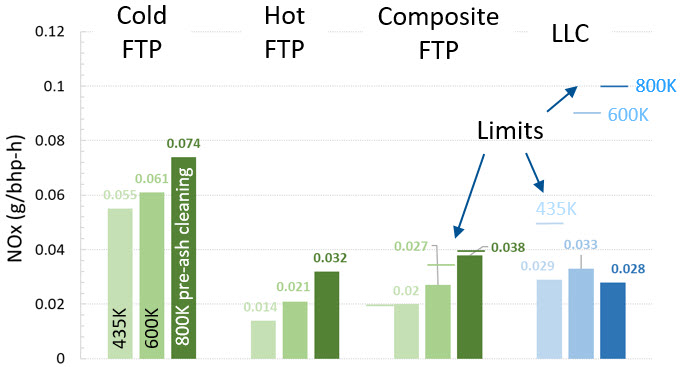Can heavy-duty trucks meet US ultra-low NOx standards ?
Option 1: Conventional diesel with advanced hardware and after-treatment system
This is a summary based on the latest presentation of this work by Southwest Research Institute, at the 32nd CRC Real World Emissions Workshop
Background
California has set revised ultra-low NOx standards which will require heavy-duty vehicles to emit 90% lower NOx starting 2027. The US EPA is contemplating a similar standard nationwide.
This is an update on a multi-year effort led by SWRI to demonstrate the feasibility of meeting such stringent standards – without impacting CO2 emissions which also tighten in 2024 and 2027.
Testing was done on a 15L diesel engine with modified calibration and added hardware, notably cylinder deactivation which allows for raising exhaust temperature for early urea dosing, while also reducing fuel consumption.
An advanced after-treatment system was used, which includes a light-off SCR and ammonia slip catalyst, to enable early SCR light-off and reduce low temperature, low load NOx emissions.
The after-treatment system was aged to various mileages associated with intermediate and end of life mileage accumulation, and tailpipe NOx was measured on the FTP and low load cycle (LLC).

The after-treatment system was aged to various mileages associated with intermediate and end of life mileage accumulation, and tailpipe NOx was measured on the FTP and low load cycle (LLC). An accelerated aging was used, which accounts for both hydrothermal and chemical (sulfur) exposure.
As shown here, the emissions on the FTP were right on the target at 435,000 miles (0.02 g/bhp-h), and within the target with some margin at higher mileages. On the LLC, the emissions were well within the standards.
What do those numbers really mean ?
The NOx conversion is at 99.5% after 800,000 miles of operation. At ~ 100,000 miles per year of driving for a Class 8 long haul truck, that’s 99.5% conversion after 8 years of catalyst degradation – if it can be called that !
What about CO2 ? Doesn’t the CO2 go up given the added backpressure and thermal management ?
Nope – cylinder deactivation does the trick here. Analysis done on vocational and transient cycles shows that it actually will reduce by 1 – 5% compared to pre UL NOx truck.
Isn’t there a NOx – PM trade-off ? Would particulates increase ?
Nope again – PM emissions were found to be below the new standard which is also further reduced by 50% compared to pre-2024 standards. The DPF is very efficient at filtration, especially when it accumulates ash at longer mileages.

So what next ?
Testing is going to continue with ash cleaning. Also more work is being done with the EPA to test another system with a modified underfloor catalyst. N2O emissions (not shown here) are currently below the limit as well but the improved catalyst (an iron-copper hybrid) has the potential to further reduce the laughing gas.
There is more work being done in other research groups to show that even lower emissions can be achieved, especially at that 435K mile marker where there is little compliance margin in this study.
If you like such content, check out the monthly newsletter covering the latest on sustainable transportation technologies and regulations. Sign up below.
Like it ? Share it !
Other recent posts
Conference Summary – Hydrogen for Sustainable Mobility Forum
![]()
A summary of the “Hydrogen for Sustainable Mobility Forum” conference held in Turin.
Cummins new engines introduced and poised to meet MY2027 standards
![]()
A round-up of the recently announced engines which will meet the upcoming EPA MY 2027 standards.
Biodiesel and Renewable diesel production in the US hits a speedbump
![]()
Biodiesel and renewable diesel production in the U.S. has slowed down significantly in 2025. Here’s why.

